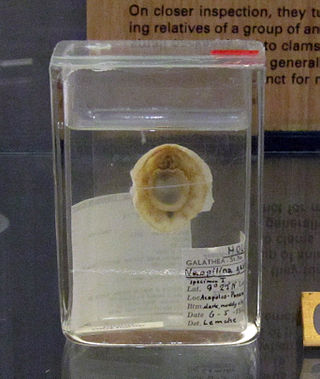
The Sipuncula or Sipunculida is a class containing about 162 species of unsegmented marine annelid worms. Sipuncula was once considered a phylum, but was demoted to a class of Annelida, based on recent molecular work.

The Echiura, or spoon worms, are a small group of marine animals. Once treated as a separate phylum, they are now considered to belong to Annelida. Annelids typically have their bodies divided into segments, but echiurans have secondarily lost their segmentation. The majority of echiurans live in burrows in soft sediment in shallow water, but some live in rock crevices or under boulders, and there are also deep sea forms. More than 230 species have been described. Spoon worms are cylindrical, soft-bodied animals usually possessing a non-retractable proboscis which can be rolled into a scoop-shape to feed. In some species the proboscis is ribbon-like, longer than the trunk and may have a forked tip. Spoon worms vary in size from less than a centimetre in length to more than a metre.

The X chromosome is one of the two sex chromosomes in many organisms, including mammals, and is found in both males and females. It is a part of the XY sex-determination system and XO sex-determination system. The X chromosome was named for its unique properties by early researchers, which resulted in the naming of its counterpart Y chromosome, for the next letter in the alphabet, following its subsequent discovery.

Ploceidae is a family of small passerine birds, many of which are called weavers, weaverbirds, weaver finches, or bishops. These names come from the nests of intricately woven vegetation created by birds in this family. In most recent classifications, the Ploceidae are a clade that excludes some birds that have historically been placed in the family, such as some of the sparrows, but which includes the monotypic subfamily Amblyospizinae. The family is believed to have originated in the mid-Miocene. All birds of the Ploceidae are native to the Old World, most in Africa south of the Sahara, though a few live in tropical areas of Asia. A few species have been introduced outside their native range.

Monoplacophora, meaning "bearing one plate", is a polyphyletic superclass of molluscs with a cap-like shell, inhabiting deep sea environments. Extant representatives were not recognized as such until 1952; previously they were known only from the fossil record, and were thought to have become extinct 375 million years ago.

Asphodelaceae is a family of flowering plants in the order Asparagales. Such a family has been recognized by most taxonomists, but the circumscription has varied widely. In its current circumscription in the APG IV system, it includes about 40 genera and 900 known species. The type genus is Asphodelus.

The bootlace worm is a species of ribbon worm and one of the longest known animals, with specimens up to 55 m (180 ft) long being reported. Its mucus is highly toxic.

Histeroidea is a superfamily of beetles in the infraorder Staphyliniformia.

Chlorokybus is a multicellular (sarcinoid) genus of basal green algae or charophyte. It has been classified as the sole member of the family Chlorokybaceae, which is the sole member of the order Chlorokybales, in turn the sole member of the class Chlorokybophyceae. It grows on soil and rock surfaces, and is rare.

Dracaena aletriformis is commonly known as the large-leaved dragon tree. These plants are found in forest in the eastern areas of South Africa from Port Elizabeth to northern and eastern Limpopo. They are also found in Eswatini, but are most common in the coastal and dune forests of KwaZulu-Natal.

Aspidosiphonidae is a family of peanut worms. It is the only family in the monotypic order Aspidosiphonida, which is in the class Phascolosomatidea.

Phascolosomatidae is a family of peanut worms. It is the only family in the order Phascolosomatida, which is in the class Phascolosomatidea.

Themiste is a genus of peanut worms. It is the only genus in the family Themistidae.

Golfingiida, also known as the Golfingiiformes, is an order of peanut worms. The tentacles form a circle around the mouth, while those of the sister taxon, Phascolosomatidea, are only found above the mouth. Most species burrow in the substrate but some live in the empty shells of gastropods. It is an order of the class Sipuncula, and contains the following families:
Onchnesoma is one of the two genera that constitute the family Phascolionidae of Phylum Sipuncula, described by Koren and Danielssen established in 1873 as the type species to Onchnesoma steenstrupii.
The Platyproteum are a genus of parasitic alveolates in the phylum Apicomplexa. Species in this genus infect marine invertebrates.

The annelids, also known as the segmented worms, are a large phylum, with over 22,000 extant species including ragworms, earthworms, and leeches. The species exist in and have adapted to various ecologies – some in marine environments as distinct as tidal zones and hydrothermal vents, others in fresh water, and yet others in moist terrestrial environments.
Tristromaviridae is a family of viruses. Archaea of the genera Thermoproteus and Pyrobaculum serve as natural hosts. Tristromaviridae is the sole family in the order Primavirales. There are two genera and three species in the family.
Thysanocardia procera is a marine invertebrate belonging to the phylum Sipuncula, the peanut worms. It is a cylindrical, unsegmented worm with a crown of tentacles around the mouth. It is native to shallow seas in the northeastern Atlantic Ocean.

Sipunculus is a genus of worms belonging to the family Sipunculidae.
















